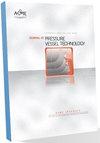Stress Analysis of ASME Section X Flanges Using Classical Lamination Theory
IF 1.4
4区 工程技术
Q4 ENGINEERING, MECHANICAL
Journal of Pressure Vessel Technology-Transactions of the Asme
Pub Date : 2023-03-24
DOI:10.1115/1.4057029
引用次数: 0
Abstract
Abstract The increased usage of fiber reinforced plastic (FRP) composite pressure vessels and piping components in the past decades in the residential and industrial sectors is attributed to the FRP material resistance to corrosion and chemical attacks. FRP composite flanges are, however, known for their anisotropic behavior. In the ASME code section X, FRP composite flanges are treated using an analytical approach derived from that metallic flanges in addition to the fact that the geometries are made to fit them as much as possible and not designed independently. This is known to have caused structural flaws for certain FRP flange classes and sizes. Using a recently developed anisotropic FRP flange approach, it is proposed to identify the most critical flanges by analyzing the flange parameters such as flange ring rotation and stresses in their different parts; gasket, flange ring, hub, and shell subjected to pressure loading. The study on the strength of flanges described in ASME section X RD-620.1 table, will reveal the most critical size and class flanges and their highly stressed locations. To conduct such a study, the selected flange material is an E glass/Vinyl Ester laminate composite. The study shows that FRP flanges of classes 25 and 50 are most vulnerable and should comparatively be less loaded. The stresses are found to reach 50 MPa in the shell and 58 MPa in the flange ring while the maximum flange rotation is 0.83 deg.基于经典层合理论的ASME X截面法兰应力分析
在过去的几十年里,纤维增强塑料(FRP)复合压力容器和管道部件在住宅和工业部门的使用越来越多,这归功于FRP材料耐腐蚀和化学侵蚀。然而,FRP复合法兰因其各向异性而闻名。在美国机械工程师协会(ASME)规范第X节中,玻璃钢复合材料法兰的处理采用了从金属法兰中衍生出来的分析方法,此外,几何形状要尽可能地与金属法兰相适应,而不是单独设计。已知这导致了某些FRP法兰等级和尺寸的结构缺陷。采用近年来发展起来的各向异性玻璃钢法兰方法,通过分析法兰环旋转和各部位应力等参数,识别出最关键的法兰;垫圈、法兰环、轮毂和壳体承受压力载荷。对ASME X RD-620.1表中描述的法兰强度的研究将揭示最关键的尺寸和等级的法兰及其高应力位置。为了进行这样的研究,选择的法兰材料是E玻璃/乙烯基酯层压复合材料。研究表明,25级和50级的FRP法兰最脆弱,应相对减少载荷。当法兰最大旋转0.83°时,壳体内应力达到50 MPa,法兰环内应力达到58 MPa。
本文章由计算机程序翻译,如有差异,请以英文原文为准。
求助全文
约1分钟内获得全文
求助全文
来源期刊
CiteScore
2.10
自引率
10.00%
发文量
77
审稿时长
4.2 months
期刊介绍:
The Journal of Pressure Vessel Technology is the premier publication for the highest-quality research and interpretive reports on the design, analysis, materials, fabrication, construction, inspection, operation, and failure prevention of pressure vessels, piping, pipelines, power and heating boilers, heat exchangers, reaction vessels, pumps, valves, and other pressure and temperature-bearing components, as well as the nondestructive evaluation of critical components in mechanical engineering applications. Not only does the Journal cover all topics dealing with the design and analysis of pressure vessels, piping, and components, but it also contains discussions of their related codes and standards.
Applicable pressure technology areas of interest include: Dynamic and seismic analysis; Equipment qualification; Fabrication; Welding processes and integrity; Operation of vessels and piping; Fatigue and fracture prediction; Finite and boundary element methods; Fluid-structure interaction; High pressure engineering; Elevated temperature analysis and design; Inelastic analysis; Life extension; Lifeline earthquake engineering; PVP materials and their property databases; NDE; safety and reliability; Verification and qualification of software.

 求助内容:
求助内容: 应助结果提醒方式:
应助结果提醒方式:


